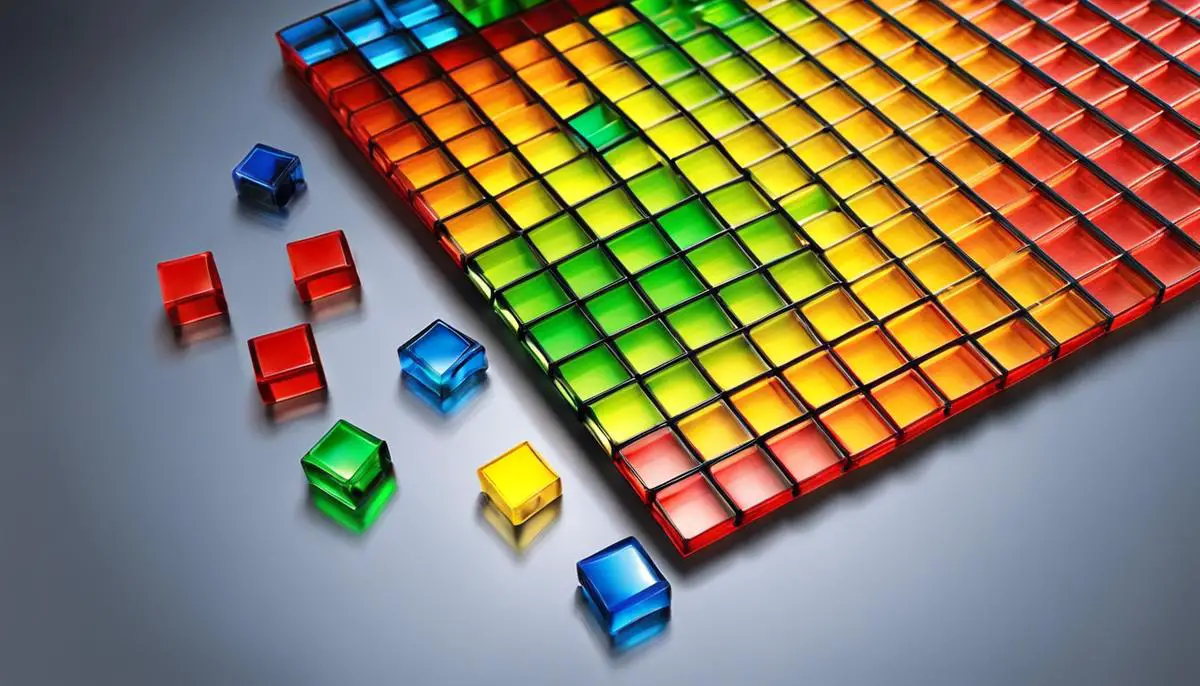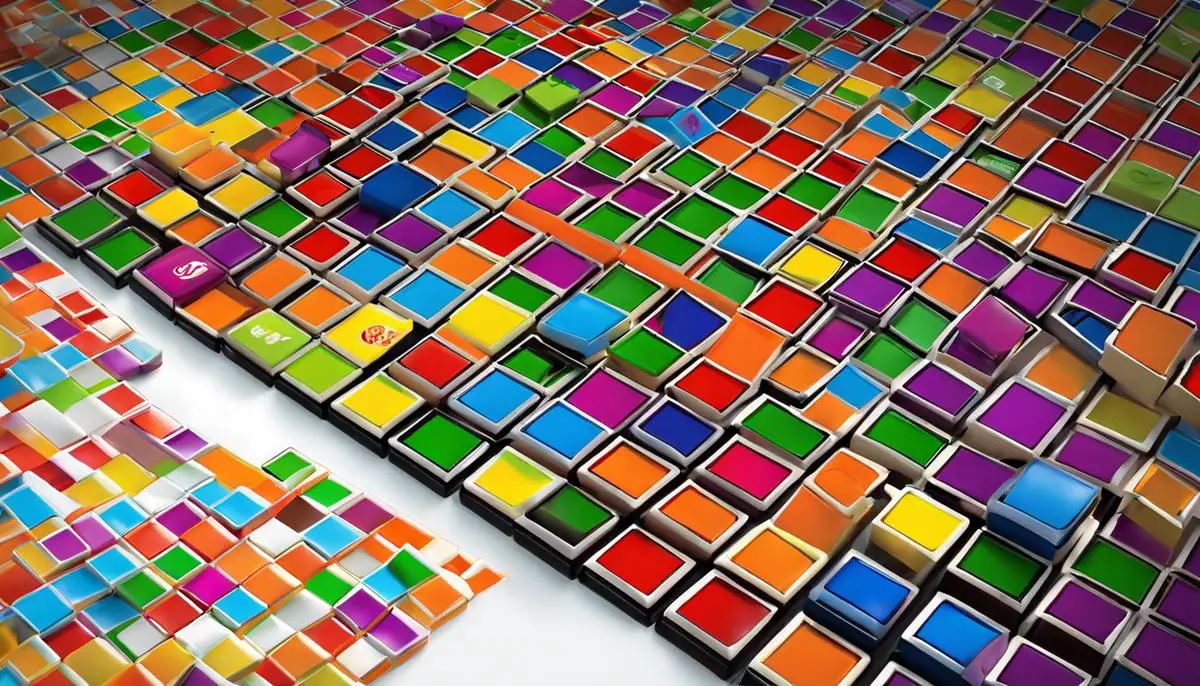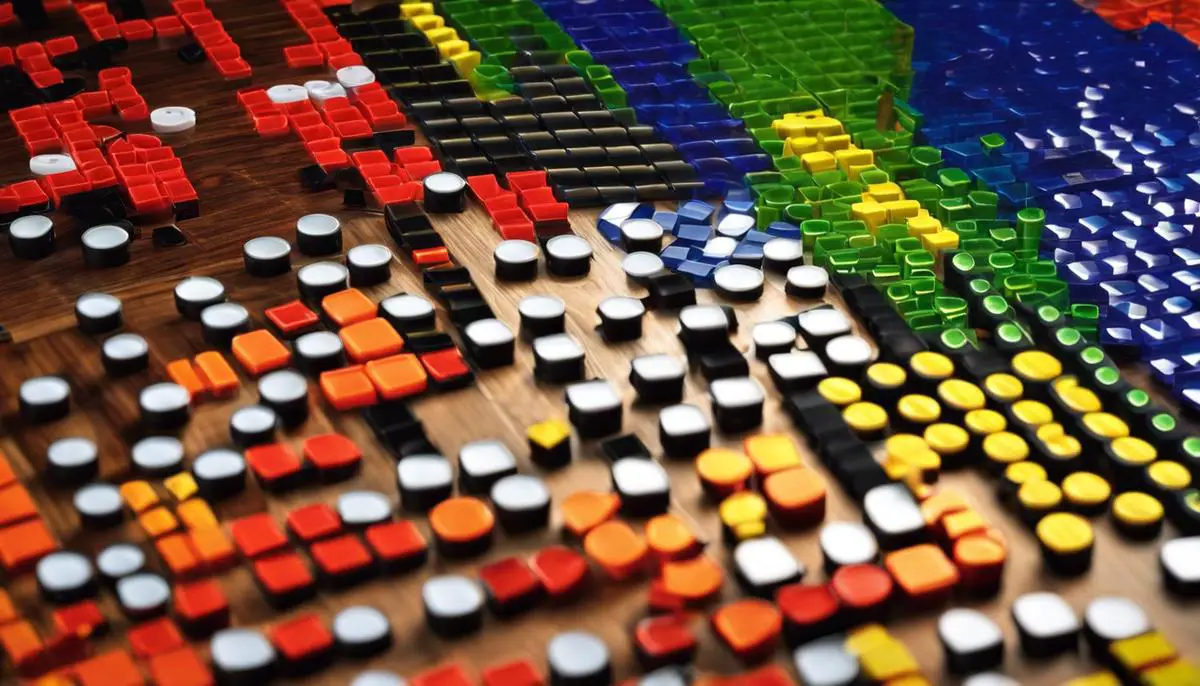Whether you’re a seasoned player or a beginner enthusiast, mastering the art of Blokus strategy can significantly enhance your gameplay and competitive edge. This game offers an engaging blend of tactical challenges and strategic thinking that reward those who understand its depth and nuances. The aim of this comprehensive guide is to equip you with a multifaceted game plan that transcends the basic understanding of the Blokus to advanced techniques. It delves deep into the game mechanics, understanding the balance of offense and defense, and adeptly responding to opponents’ moves. Get ready to transform your Blokus game into a tactical battle of wits, creativity, and strategy.
Understanding Blokus Basics
Mastering Blokus: Rules and Winning Strategies
If you’re a tabletop enthusiast looking for a new challenge, Blokus is just the game to test your wits. Revered for its balance of simplicity and complexity, it’s a perfect addition to any game night. So, let’s delve into the world of Blokus – learning the rules, understanding the game mechanics, and uncovering proven strategies to give you the upper hand in this exciting board game.
Blokus is a strategy board game designed for two to four players. Each player receives 21 pieces at the start of the game, ranging in different shapes and sizes referred to as Polyominoes. These pieces are harmoniously distributed, from one square up to five. The objective? Try to place as many of these pieces on the board as possible. But, hang on, there’s a catch – each piece you lay down must touch another piece of the same color, but only at the corners, not the sides. Intriguing, isn’t it?
Be ready to kick-off the game from your own corner of the board. If you are two or four players, each person gets a corner. But in a three-player game, one player assumes control of two colors. Start with your largest piece. Why? As the game progresses, it becomes trickier to fit these larger shapes on the board.
As you embrace the adventure, remember you can place your piece in any orientation. Spin it, flip it, turn it – whatever helps you fit your piece on the board, within the rules of course!
Winning the game of Blokus requires cunning strategy and spatial reasoning. It’s not merely about placing every piece on the board. It’s about effectively blocking your opponents while maintaining room for your own pieces. It’s like a colourful battle of territory on a square grid.
Always be on the look-out for open spaces. The more spread out your pieces are, the more territory you have to operate. This also minimizes the risk of getting boxed in by your opponents. Moreover, go for central control of the board; dominating the center gives you more room to branch out in different directions.
Another trick of the trade? Create ‘escape routes’. Escape routes refer to setups that allow you to bridge into territory that is otherwise hard to reach. It’s a smart way to slip through your opponent’s frontline and stake a claim on virgin territory!
Developing a strategy will depend on whether you’re playing defensively or offensively, both are valid strategies. Defensive players strive to block others from gaining territory, while offensive players primarily focus on spreading their own pieces across the board.
Playing Blokus is like nurturing a captivating yet challenging hobby. With each game, you will inevitably learn new iterations and strategies. Above all, remember to enjoy the experience. Fierce competition, remarkable strategies, and thrilling finishes – that’s the magic of Blokus. Game on!

Advanced Piece Placement Strategies
Decoding the Game of Blokus – The Edge of Strategic Piece Placement
Believe it or not, in the realm of Blokus, piece placement is often the key to a triumphant victory or a gnawing defeat. Strategic placement becomes a mounting concern as the game progresses, transforming the journey of Blokus into a fine blend of strategy, foresight, and quick adaptability to changing circumstances on the board. If you’ve already dipped your toes in the basic essentials of Blokus, now it’s time to delve deeper into the impact that strategic piece placement has on the endgame result.
In the multifaceted grid of Blokus, every tile tosses its special charm, each bearing potential to alter the game’s course. Recognizing the subtle power within each tile, and understanding how best to employ it, can elevate your game play.
Ever wonder why some players tend to exhaust their bigger pieces first? An integral reason is that as the battlefield grows increasingly congested, maneuverability for large pieces dwindles quickly. Employing larger pieces earlier can ensure they don’t land up as deadweight as the game advances.
Stemming from this idea is the concept of harboring versatility with your stock of pieces. Don’t play to only exhaust the biggest pieces; instead, maintain an equilibrium in your inventory to accommodate unexpected changes. The key to this balance lies in understanding the pieces themselves – recognizing which ones provide the highest flexibility due to their unique shapes and configurations can provide a definite edge in the game.
Frequently, players new to Blokus aim for an even spread, which although an excellent starting point, may sometimes leave them vulnerable to isolation. The counter strategy? Establish connectivity. Again, the pieces play pivotal roles, as some can bridge gaps brilliantly, maintaining a line of communication between your scattered forces on the board. Remember, in the world of Blokus, isolation is a dreadful curse and connectivity is your strongest ally!
While it’s all well and good to focus on deploying your own pieces strategically, it’s equally crucial to take note of your opponents’ moves. Akin to a dance, you must match your opponents’ step for step, embracing not only your plans but adapting to theirs as well. Placing pieces that limit their directional growth can prove to be a game-changing move.
As we’ve seen, the Blokus board can quickly mutate into a battlefield, rife with sophisticated strategies and clever techniques. But amidst the competitive hustle, it’s easy to forget that Blokus is a journey – a thrilling escapade marked by epic triumphs, calculated risks, and learning from defeats. So, keep exploring, keep placing, keep strategizing. With each game of Blokus, the pieces and placements will reveal new lessons and inspirations. So go on, the board awaits – strategize, play, and most importantly, enjoy!

Defensive Strategies
In the thrilling world of Blokus, outthinking your opponents through effective defensive strategies can lead you towards victory. So, how can you devise that winning defensive strategy?
To unleash your defensive prowess, consider your reaction to your opponent’s moves. A counter-strategy is essential and it means being mindful of pieces dropped by your competitors. Here’s a nifty trick – try to circle your opponent’s pieces. In this way, you can limit their expansion and trap them in a restricted area. This tactic can effectively impede your opponent’s progress, while providing you with more free squares to conquer.
Another defensive weapon to wield in Blokus is the judicious use of corner points. These points are the only places where you can place your pieces adjacent to each other. Utilizing them wisely can be a powerful way to keep your opponent away and safeguard your territory.
Often in Blokus, you are faced with situations where the opponent is closing in on your corner points. These challenges call for the “block and save” technique. Defend your corner points by strategically placing a piece to halt your opponent’s advances, saving your corner points for future moves.
By virtue of the game’s mechanics, using your small pieces as defensive shields comes in handy. Smaller pieces can be placed in the diminishing spaces towards the end of the game. While some might advocate using these pieces early on, they can be your last line of defense when it comes to blocking opponent’s pathways.
Pieces placement also plays a vital role in defensive strategies. An L-shaped Tetris-style piece, for example, can be placed in a way which blocks an opponent but still leaves you with a corner to continue your game. This way, your piece is effectively serving the dual function of defense and offense.
Let’s not forget one of the less obvious approaches – the psychological defense. Present yourself as a challenging contender by spreading your pieces wide across the board. The sight of your pervasive colors might deter your opponents and force them into making rushed decisions. Remember, Blokus is not only a game of squares and moves, but also one of minds and perceptions.
Adapting to your opponents’ tactics is pivotal, as no single strategy will be universally effective. The best defense in Blokus will always be a flexible one, adaptable to the ever-changing scenarios of each game.
Every journey of Blokus is unique; each strategy, different. But rest assured, sharpening your defensive skills in this captivating game of Blokus will not only add layers to your expertise but elevate your enjoyment to unmatched levels. So, get those pieces ready, let defenses unfurl, and prepare for an exhilarating ride in world of Blokus.

Photo by alex_andrews on Unsplash
Offensive Strategies
Now that the game mechanics and defensive strategies of Blokus are well underway, a comprehensive understanding of robust offensive strategies is necessary to up the ante in your favor. Navigating the Blokus battlefield requires a strong offensive play, and the following tactics might just give you the edge you need in your next game.
One hard and fast rule in Blokus’s offensive game is the use of the “pinch” maneuver. This method involves placing tiles in such a way that it restricts your opponent’s potential moves, forcing them to waste valuable pieces or fleeing to less strategic parts of the board. This move might not be instantly gratifying, but it sets the stage for a more significant positional advantage later in the game.
Employing feints and misdirections can also be clever offensive techniques. Though Blokus is a deterministic game (meaning there’s no room for luck or chance), there’s a psychological component at play. If you can manipulate your opponent into thinking you’re targeting one area of the board, they might overcommit to defense, allowing you to exploit weaknesses elsewhere.
“Corners are your friends” might appear defensive at first glance, but remember that every defense creates offense. Corner points not only protect your territory but also give you opportunities to jump and derive breaches in your opponents’ defenses.
A key offensive strategy: the artful use of small pieces. Deploy these pieces strategically to invade valuable territory, create escape routes, or disrupt opponents’ positions. Remember, the smaller pieces offer more flexibility and can fit into less accessible spots on the board; they are your cavalries, ideal for quick strikes and raiding techniques in the later stage of the game.
Conversely, the allure of larger pieces shouldn’t be underestimated. While it’s generally good advice to use larger pieces first, some larger tiles, especially the “F” and “W” shapes, can perform extraordinary feats if saved for the endgame. They can annex large chunks of territory very quickly and limit the places where your opponents can play.
In the end, it’s all about balance. Should you focus more on controlling the center or preserving your pieces’ connective power? Depending on the game’s complexion, you might need to shift your offensive focus between these two strategies.
In conclusion, offensive strategies in Blokus are varied and complex, begging for creativity and innovative thinking. From simple pinches to feints, aggressive corner utilization, artful use of small and large pieces, and striking a balance between board control and piece connectivity – there are countless opportunities to persevere. Like all excellent strategic games, the tactics are endless, and the perfect strategy is just waiting for you to discover it, bringing endless fascination to this beloved board game – Blokus!

Adapting Strategies Based on Opponents

Through detailed exploration and case studies, this comprehensive guide has taken you on a journey from fundamental knowledge to advanced strategies in Blokus gameplay. The understanding of advanced piece placement strategies, the application of astute defensive tactics, the adoption of proactive offensive measures, and adapting to opponents’ strategies are all vital to turning the tide in your favor. Ultimately, thriving in Blokus is not just about understanding the rules, but also acknowledging the dynamics of the game. Cultivate the fusion of strategic thinking, creativity, and flexibility derived from this guide to your advantage. As you continue to practice and apply these insights, you’ll become a more skilled and feared Blokus player.
